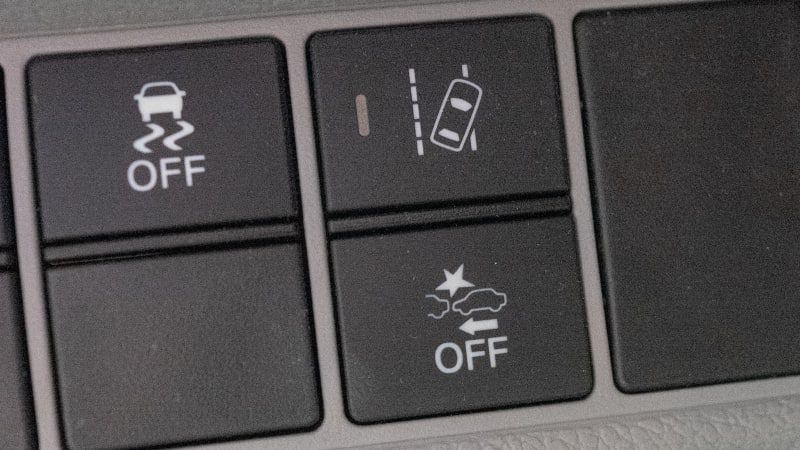Lane-keeping assist and lane departure warning: How they work and what's the difference

One of the most fundamental advanced safety systems — part of what many in the automotive industry call Advance Driver Assistance Systems — in a modern car is lane-keeping assist, or lane-keep assist. It’s a simple idea, but it’s anything but simple in execution. Accordingly, there are many variations of lane-keeping systems across vehicle brands.
What is lane-keeping assist?
Lane-keeping assist is exactly what it sounds like: an active system that helps the driver keep their car in the lane of travel.
Read more: What is adaptive cruise control?
How does lane-keeping assist work?
Using cameras looking ahead at the road surface, the lane-keeping assist (LKA) system monitors for road markings, including the stripes along the sides of the road as well as the lane dividing markers, in order to keep the vehicle centered in its lane. Each system requires its own level of confidence in the lane markings, but once the threshold is met, the system will typically announce its availability through an icon on the vehicle’s instrument panel. The system can then be activated by the driver, often with a button on the steering wheel.
Read more: All our latest news on autonomous vehicles
If the lane markings continue to meet the system’s threshold for validity, it will continue to keep the vehicle in the lane of travel until the driver deactivates the system either manually or by using the steering wheel, or until it no longer has sufficient confidence in the position of the road markings.
In addition to the computerized camera system monitoring the road markings to determine where the lane is and where it’s going, LKA also requires the vehicle be able to alter its path, either through the use of the steering system or by braking along one side of the car or the other. Systems that use the steering are typically more responsive and capable of dealing with more road curvature than brake-based LKA systems.
What lane-keeping assist doesn’t do
As simple as the lane-keeping assist system’s mission sounds — there’s not much that’s more basic to driving a car than staying in the proper lane — making that system robust and reliable in the real world presents a serious challenge. Faint lane markers, temporary construction or roadworks, inclement weather, road debris, and other conditions or factors can make it impossible for even the best lane-keeping systems to function. That means it’s always incumbent upon the driver to maintain attention and control of the vehicle.
Read more: What is adaptive cruise control?
Some lane-keeping assist systems will first issue an alert when they detect lane-departure is imminent (this is often marketed as a separate feature, as well, called lane-departure warning). If the driver doesn’t respond to the warning by adjusting the steering, the lane-keeping assist system will generally try to keep the car in the current lane of travel. Some LKA systems will use the steering to accomplish this, while others may use the brakes on one side of the car to gently alter its trajectory; yet others may use a combination of both.
In general, lane-keeping assist systems are just that — assistance systems, which are easily overridden by the driver’s inputs to the steering wheel.
What is the difference between lane-keeping assist and lane departure warning?
As noted above, lane-keeping assist systems are typically parts of larger active safety feature suites, and those suites often include other lane-keeping-related functions. Among those are:
Road-departure assist or mitigation (RDM or RDA)
Lane-departure warning (LDW)
Lane-centering assist (LCA)
Road-departure assist is often part of the LKA system, but it is sometimes classified as a separate function; it does what its name indicates, helping to prevent the vehicle from leaving the road surface. It does this through the same sensors and controls as the LKA system would.
Lane-departure warning is often integrated with LKA, as alerting the driver is the first stage of keeping the vehicle in the lane in a driver-assistance paradigm. As a passive (as opposed to active, meaning it only warns the driver that they are drifting out of their lane but doesn’t correct the problem) system, lane-departure warning may be considered the most basic technology designed to help a driver keep their vehicle in the proper lane.
Lane-centering assist is what people sometimes are thinking of when they hear lane-keeping assist. While LKA will help keep you from errantly departing your lane, LCA will help keep the vehicle near the center of the lane, a subtle but important distinction, as the LCA systems function more like a semi-autonomous vehicle.
Popular lane-keeping assist systems:
Toyota’s Lane-Departure Alert with Steering Assist
Chrysler Group’s LaneSense
BMW’s Active Lane Keeping Assistant
Volkswagen’s Lane Assist
Volvo’s Lane Keeping Aid
Nissan’s ProPilot Assist
Read more: What is Tesla AutoPilot, and is it really Full Self-Driving?
Lane-keeping assist is just one automated technology designed to assist drivers. Some more advanced systems include Tesla’s Autopilot, GM’s Super Cruise and Ford’s BlueCruise, which bundle technologies that keep the vehicle in its intended lane while also controlling the accelerator and brakes. The GM and Ford systems are geofenced to operate in only specific stretches of highway, whereas Tesla’s system operates more freely (for better and for worse). Tesla also does not monitor the driver’s attention as Super Cruise and BlueCruise do.
No automaker in America currently offers a fully automated, self-driving vehicle that’s capable of moving passengers from one place to another without intervention from a human driver.
Related video:







